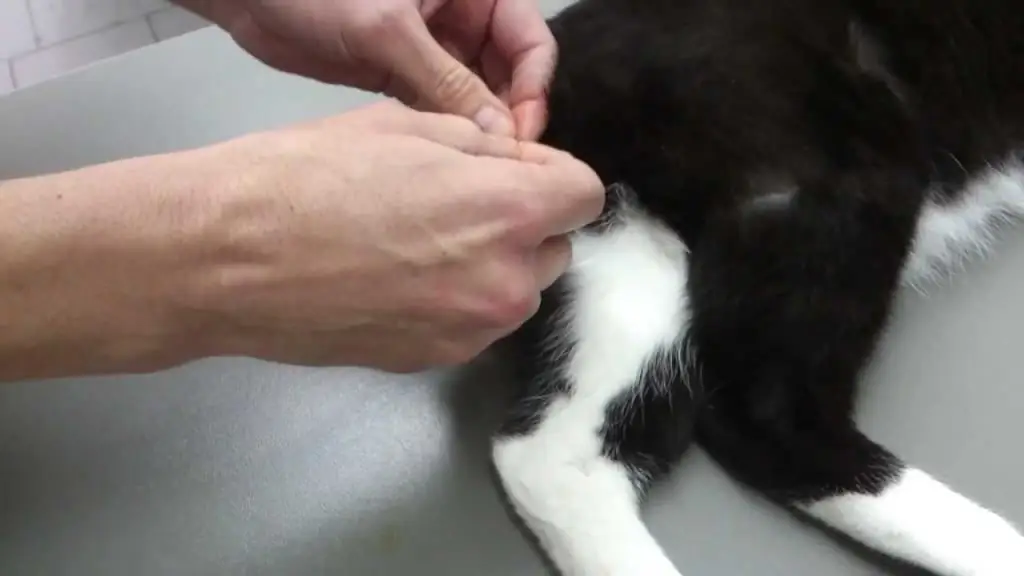2026 Author: Priscilla Miln | [email protected]. Last modified: 2025-01-22 17:55:26
Every owner of a dog will certainly face a molt in a spitz. During age changes, the dog loses most of its coat, which makes it look less attractive. We will analyze when the shedding of the Spitz begins. We will find out what causes profuse hair loss in a dog, what signs may indicate a pet’s illness.
General information
Spitz are very similar to small fluffy bears. The coat is soft and thick, they have a very dense undercoat. The integumentary outer hair wraps the neck, paws, tail and body. The undercoat consists of thick and soft hair that lies very close to the dog's skin.

During the age sheds, Pomeranians start to look shabby and untidy, but this is a natural process that all owners of dogs of this breed should be aware of. The growth of hair on the body of a pet goes through a certain cycle. First, it begins its development from the follicle. Under the influence of external factors, the hair receives certaindamage, its bulb is destroyed. During molting, hair loss occurs. After that, a new one begins to grow in its place.
The spitz shedding is most noticeable during the age change of coat. Animals that do not participate in the reproduction of their offspring and live in warm apartments molt almost imperceptibly for the owner.
Let's list the main reasons why spitz shedding occurs.
Age change of coat

The main reason why owners may experience pet shedding is the age-related change of coat in a Spitz. Until two months old, puppies look most adorable. They have soft, baby and fluffy fur. Most often, sellers take the first photos at this age, as the dog looks the most attractive.
From the age of three months, the Pomeranian begins to change very significantly. Their ears grow and the muzzle stretches. During this period, the change of wool to an adult begins, but it is not yet so noticeable. The first molt in Spitz occurs at the age of 4-5 months. It is at this time that the dog is almost completely bald. The puppy looks big-eared and a little disproportionate. Abundant hair loss during such a period is considered as a natural process, and therefore you should not worry about it. The puppy begins to grow significantly with hair at 6-7 months. He is becoming more and more like an adult Spitz.
Also, the spitz molt is quite abundant a year. The dog again loses a lot of hair and finally "changes clothes" into an adult fur coat. This line is calledjunior. Subsequent similar changes are not so noticeable. The coat of a dog is finally formed at the age of 2-3 years.

Seasonal molt
In response to changes in ambient temperature and the length of daylight hours, an increased release of melanin occurs in the pet's pituitary gland. It is this hormone that is responsible for seasonal shedding in Spitz. It happens twice a year: in spring and autumn. Before the heat, the dog loses most of its undercoat. In this case, the number of integumentary hairs remains unchanged. Before the cold weather, the Spitz begins to grow a thick and warm undercoat. Animals that live in warm room conditions during the winter shed evenly throughout the year.
Hormonal changes in the body
In most cases, shedding due to hormonal fluctuations is more typical for females. Bitches may shed a small amount of hair during estrus. In addition, they can almost completely lose their entire coat after childbirth. This is a natural process that is associated with feeding puppies and the lack of vitamins and minerals. When buying a baby, you should not worry if his mother looks bald and nondescript. For a Spitz, this is quite normal, so you should not be afraid that a puppy can inherit any disease from an adult dog.
Let's list the main types of hormonal changes that can cause shedding in Spitz:
- Brittle hair around the chest, back and neck can occur with a lack of thyroid hormones.
- Excess cortisol in the bodyleads to a deterioration in the quality of wool.
- When females have high levels of estrogen, hair loss around the genitals can occur.
- After sterilization, due to the lack of the mentioned hormone, the rate of hair growth in bitches slows down significantly.
More possible causes of shedding

We list other possible causes of shedding in Spitz:
- allergic reaction to food, hygiene products, antiparasitic drugs, medicines, etc.;
- eating poor quality feed;
- avitaminosis, lack of minerals in the body;
- inflammatory processes in the body, drop in immunity due to disease;
- parasites - fleas, ticks, helminths;
- fungus.
Puppies 4-6 months of age that have not been shedding, as well as adult Pomeranians over the age of four, are at risk for alopecia X. In this condition, hair loss occurs in the dog. Only the limbs and head remain hairy. Most often, the disease manifests itself after shaving off soft fluff in a puppy, as well as after a very short haircut in an adult dog.
How to care for a dog during shedding season

During intensive shedding, the Pomeranian needs to be combed every day with a special brush. It consists of small iron long teeth. They help remove loose hair, save hair from tangling, massage the skin and stimulate blood circulation. For puppies, it is better to choose a brushwith soft bristles, so as not to damage the delicate skin. To speed up the process of hair loss, you can use slickers.
During the molting period, the German Spitz should not be sheared, otherwise the coat may stop growing altogether. You should also avoid swimming. Soap and water can tangle loose hair into tangles that will be very difficult to unravel, and therefore, most likely, they will have to be cut, which is undesirable during this period. Bathing a dog is worth in extreme cases: before exhibitions or to wash off serious pollution.
Pomeranian diet during shedding
During shedding, the dog needs to be given vitamins and minerals. Food should be properly balanced, contain a lot of protein. It is worth entering into the diet:
- lean beef and chicken;
- cereals;
- cooked offal;
- vegetables;
- sea fish.
When to start sounding the alarm

Shedding in a Spitz may indicate a disease of the animal. Unseasonal heavy hair loss that does not stop can be signs of a dog's he alth problems.
The main symptoms indicating pathogenic molting in Spitz:
- complete baldness of certain areas of the skin;
- itching, skin inflammation, wounds and boils;
- hair loss around the eyes, redness of the mucous membrane;
- baldness and skin darkening;
- hair loss around the female genitals;
- thin and brittle hair;
- dull coat;
- absence oruntimely age lines.
The condition of the coat first of all indicates the he alth problems of the animal. There are a large number of diseases that can lead to profuse hair loss. For an accurate diagnosis of the cause, the dog should be seen by a doctor. In the absence of timely treatment, the coat may not recover completely. Some diseases can lead to serious complications.
Conclusion
Thus, Pomeranians are famous for their thick and fluffy coat. Their appearance changes significantly during age molts. During this period, the dog must be treated with special attention. Lost hairs should be combed out to avoid matting. It is highly undesirable to bathe a dog. If a disease of an animal Spitz is suspected, it is necessary to show it to a specialist.
Recommended:
How do cats tolerate castration: how long does a cat recover from anesthesia, how does behavior change, rules of care. Food for neutered and neutered cats

Owners of domestic cats often resort to castration. More often than not, this is simply necessary. An adult cat needs at least 8 cats a year to feel good. It is not always possible to give him such an opportunity in an ordinary city apartment. It is for this reason that the deposition procedure can help. But how cats tolerate castration is what worries caring owners. We will answer this and many other questions in the article
At what month of pregnancy does the tummy appear, what does it depend on

Having learned about pregnancy, all women are interested in any changes that occur in the body. The most frequent question of future mothers is the following: “At what month of pregnancy does the tummy appear and when will its “interesting position” be noticeable? Even a doctor cannot definitely answer this question, because each pregnancy is different, and the growth of the abdomen depends on many factors. This article will help you understand this issue in more detail
If a husband does not love his wife: what are the signs? How does a husband behave if he does not love his wife?

When one of the spouses has feelings - this is a severe stress. Any changes in relationships for the worse are especially painful for a woman, since it is vital for her to be loved and desired. It is very difficult to accept the fact that a man has fallen out of love, so many wives continue to deceive themselves and play the perfect family. Such a position is very dangerous, as it presupposes inaction. It is much wiser to admit the problem and try to understand what to do if the husband does not love his wife
When does the 3rd trimester of pregnancy start? What week of pregnancy does the third trimester start?

Pregnancy is a wonderful period. And it requires special attention. Especially in the 1st and 3rd trimesters. When does the last important period begin? What features await the expectant mother at these moments? You can learn about pregnancy and its course in the 3rd trimester in this article
How much milk does a cow give per day, and what does milk yield depend on

Man has worked hard to breed various breeds of this wonderful animal. There are breeds adapted for life in different climatic conditions: in the mountains, in the harsh northern climate and in the steppe. They are shaggy and smooth, black and white, tall and not very tall. Whatever the cow, its main purpose is to give milk

